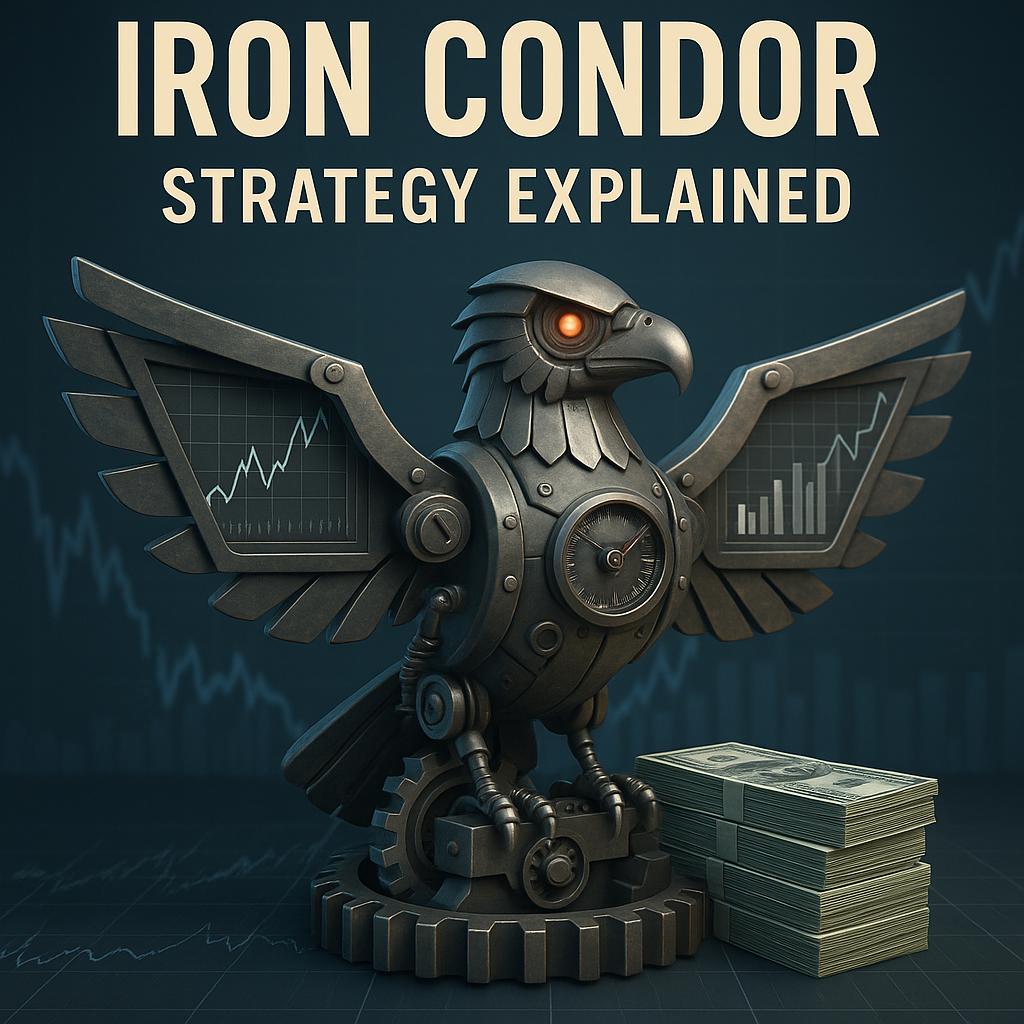Listen, I’m about to teach you the most boring, predictable, grandmother-approved options strategy that’s made me $4,000-$6,000 every single month for the past two years. It’s called an Iron Condor, and despite the badass name that sounds like a metal band or a Marvel villain, it’s about as exciting as watching paint dry in slow motion while someone reads you the phone book.
But you know what’s exciting? Collecting $4,000 a month doing almost nothing. Checking your account on Friday and seeing another $1,000 deposited while you were sleeping. Having your mortgage paid by theta decay. That shit never gets old.
So shut up about boring and let me show you how this works, why it’s perfect for people who suck at predicting market direction (that’s all of us), and how I turned this “boring” strategy into a consistent monthly income stream that’s more reliable than my actual job.
What The Hell Is An Iron Condor?
An Iron Condor is when you bet that a stock will stay within a certain range. You’re not betting it goes up. Not betting it goes down. You’re betting it stays boring. And here’s the secret that nobody tells you: Most stocks are boring most of the time. Even the “exciting” ones.
Think about it – how often does SPY actually move more than 5% in a month? Maybe twice a year. The rest of the time it’s just chopping around, theta decaying options into dust while you collect premium like a landlord collecting rent.

The Anatomy of an Iron Condor
An Iron Condor is actually two credit spreads stapled together:
Part 1: Bear Call Spread (Betting it won’t go up too much)
- Sell a call at strike A
- Buy a call at strike B (higher)
- Collect credit
Part 2: Bull Put Spread (Betting it won’t go down too much)
- Sell a put at strike C
- Buy a put at strike D (lower)
- Collect credit
Combined: The Iron Condor
- Collect premium from both sides
- Profit if stock stays between your short strikes
- Max profit = credit received
- Max loss = width of strikes minus credit
Visual Example (Because This Shit’s Confusing)
Stock: SPY at $450
Your Iron Condor:
Buy $470 call
Sell $465 call <-- Upper short strike
---[PROFITABLE ZONE]---
SPY $450 (current price)
---[PROFITABLE ZONE]---
Sell $435 put <-- Lower short strike
Buy $430 put
Profit Zone: $435 to $465 (30 point range)
Credit Collected: $200
Max Loss: $300
Probability of Profit: 68%
My First Iron Condor (And Why I Almost Quit)
First Iron Condor was on Tesla. Because I’m an idiot. This was 2021 when TSLA moved 20% weekly for fun.
The Disaster Trade:
- TSLA at $700
- Sold $750/$760 call spread
- Sold $650/$640 put spread
- Collected $500 in premium
- Felt like a genius
Two days later: Elon tweets something about Dogecoin. TSLA rockets to $780. My $500 gain turns into a $2,000 loss in 48 hours.
Lesson Learned: Never, EVER run Iron Condors on:
- Meme stocks
- Biotech
- Anything Elon Musk touches
- Chinese stocks
- Earnings weeks
- FOMC weeks (unless you like pain)
The Setup That Actually Works (And Makes Me $4-6K Monthly)
After losing money on stupid underlyings, I discovered the holy grail: Index Iron Condors.
The SPX Weekly Iron Condor System
Why SPX is Perfect:
- Cash-settled (no assignment risk)
- Most liquid options in existence
- Tax advantages (60/40 treatment)
- Can’t be manipulated by one tweet
- European style (can’t be exercised early)
My Exact Setup:
- Trade SPX (not SPY – tax reasons)
- Sell 10-delta calls and puts
- 30-45 days to expiration
- 25-50 point wide spreads
- Target: $300-500 per condor
Real Example from Last Month (November 2024)
November 1st Setup:
- SPX at 4,500
- December 15 expiration (44 days out)
The Trade:
- Sell 4,650/4,675 call spread
- Sell 4,350/4,325 put spread
- Credit received: $425
- Max loss: $2,075
- Breakeven points: 4,354 and 4,646
- Probability of profit: 68%
Management:
- November 15: SPX at 4,520 (perfect)
- Could close for $150 (65% profit)
- Decided to hold
Result:
- December 15: SPX closes at 4,490
- Both spreads expire worthless
- Keep entire $425
- Rinse and repeat
The Monthly Income Machine
Capital Required: $100,000 Condors Per Month: 20-30 Average Credit: $400 Win Rate: 70% Monthly Income: $4,000-6,000
The Math:
- 25 condors × $400 = $10,000 collected
- 18 winners × $400 = $7,200
- 7 losers × $800 (managed) = -$5,600
- Net profit: $1,600
- But wait…
The Secret: I don’t let losers hit max loss.
The Rules That Keep You Profitable
Rule 1: The 10-Delta Rule (The Most Important)
Only sell options with 10 delta or less. This means:
- 90% probability the option expires worthless
- 10% probability it goes in the money
- Wide profit range
- Time decay on your side
Why 10 Delta Works:
- SPX 10-delta is usually 3-4% away
- SPX rarely moves 4% in a month without reverting
- Gives you room to be wrong
- Can survive normal volatility
What Happens at Higher Delta:
- 15 delta: 70% win rate drops to 60%
- 20 delta: More premium but 50% win rate
- 25 delta: You’re gambling now
- 30 delta: Just buy lottery tickets instead
Rule 2: The 45-Day Sweet Spot
Why 45 Days:
- Enough premium to collect (theta hasn’t decayed yet)
- Enough time to manage if goes wrong
- Sweet spot for theta decay acceleration
- Can roll if needed
Why Not Weeklies:
- Gamma risk extreme
- No time to adjust
- One news event kills you
- Stress level: Heart attack
Why Not 60+ Days:
- Too much can happen
- Premium isn’t much better
- Capital tied up too long
- Harder to manage
Rule 3: The 2X Stop Loss
If your condor goes against you and you’re down 2X your credit, close it.
Example:
- Collected $400 credit
- Position down $800
- Close immediately
- No hoping, no praying
- Move to next trade
Why This Works:
- Prevents max loss disasters
- Keeps losses manageable
- Preserves capital
- Reduces emotional damage
Rule 4: The 50% Profit Target
When you’re up 50% of max profit, strongly consider closing.
Example:
- Collected $400
- Can buy back for $200
- That’s 50% profit
- Take it and run
The Math:
- Holding for last 50%: 20 more days
- Risk of market move: High
- Reward: $200
- Risk: $2,400
- Not worth it
Rule 5: Never Trade Through Events
Events to Avoid:
- FOMC meetings
- CPI/PPI releases
- NFP (Non-Farm Payrolls)
- Earnings (for stock condors)
- Elections
- Options expiration week
What Happens During Events:
- Volatility explodes
- Normal ranges break
- Stops get hunted
- Condors get destroyed
The Best Underlyings for Iron Condors
God Tier (Where I Make My Money)
SPX – The King
- Most liquid
- Cash-settled
- Tax advantages
- Can’t go bankrupt
- Trades until 4:15 PM
RUT – Russell 2000
- More premium than SPX
- Higher volatility
- Good for smaller accounts
- Also cash-settled
NDX – Nasdaq 100
- Tech-heavy (more movement)
- Huge premiums
- Need bigger account
- Higher risk/reward
Good Tier (Decent but Not Perfect)
SPY – The Peasant’s SPX
- Like SPX but worse taxes
- American style (assignment risk)
- More strikes available
- Good for beginners
QQQ – Tech ETF
- Liquid options
- Decent premium
- Trends more than SPX
- Careful with tech events
IWM – Russell ETF
- Small-cap exposure
- Good premium
- Less efficient than RUT
- Decent for practice
Shit Tier (Don’t Even Think About It)
Individual Stocks
- Tesla: Will move 15% because Elon sneezed
- Biotech: One FDA news = account blown
- Meme stocks: GME, AMC = guaranteed loss
- Chinese stocks: Random 30% moves
- Penny stocks: Why do you hate money?
Advanced Adjustments That Save Your Ass
When a condor goes wrong, you have options (pun intended).
Adjustment 1: The Roll Out
Market moving toward your strikes? Roll to next expiration.
Example:
- Short 4,650 call threatened
- SPX at 4,640 and rising
- Close current condor for small loss
- Open new condor for next month
- Collect additional credit
- Buys time for reversal
Success Rate: 60% (markets mean-revert)
Adjustment 2: The Wing Widening
Turn 25-wide spreads into 50-wide spreads.
Original:
- 4,650/4,675 call spread
- Risk: $2,500
Adjusted:
- 4,650/4,700 call spread
- Risk: $5,000
- But doubles breakeven range
When to Use:
- Strong conviction market won’t continue
- Have capital to support
- Early in trade cycle
Adjustment 3: The Delta Hedge
Add opposite position to neutralize delta.
Condor Threatened on Upside:
- Buy calls or call spreads
- Offsets upside loss
- Costs premium
- Insurance policy
Real Example:
- SPX condor with 4,650 short call
- SPX rallies to 4,640
- Buy 4,650/4,700 call spread for $500
- If continues up, hedge profits
- If reverses, lose hedge premium
Adjustment 4: The Conversion
Convert to single credit spread.
Example:
- Call side threatened
- Close put side for 80% profit
- Now just managing call spread
- Reduced risk
- Still profitable if reverses
Adjustment 5: The Reverse Harvey
(I made this name up but it works)
Setup:
- Call side threatened at 4,650
- SPX at 4,645
The Move:
- Close threatened call spread for loss
- Sell new call spread at 4,675/4,700
- Collect additional premium
- Move strikes with market
Risk: Market continues, you lose twice Reward: Market stalls, you profit twice
Managing Multiple Iron Condors (The Factory Approach)
Running 20+ condors monthly requires systems.
The Ladder System
Week 1: Open 5-7 condors Week 2: Open 5-7 more Week 3: Manage week 1 positions Week 4: Manage week 2 positions
Why This Works:
- Diversifies entry points
- Spreads risk across time
- Always have positions working
- Consistent weekly income
The Tracking Spreadsheet
Track everything or die confused:
Date | Underlying | Strikes | Credit | Days | P&L | Status
11/1 | SPX | 4650/4350 | $425 | 45 | +$425 | Open
11/3 | RUT | 2100/1900 | $350 | 40 | +$175 | 50% profit
11/5 | SPX | 4700/4400 | $400 | 43 | -$200 | Rolled
The Position Sizing Formula
Never risk more than 5% per position:
Account Size: $100,000
5% Risk: $5,000
Max Loss per Condor: $2,500
Max Positions: 2 spreads
As account grows, add positions
The Daily Routine (15 Minutes)
9:00 AM: Check overnight moves 9:05 AM: Review Greek exposure 9:10 AM: Identify adjustments needed 9:15 AM: Execute adjustments 9:20 AM: Done for the day
Seriously, that’s it. This isn’t day trading.
Common Iron Condor Mistakes That Kill Accounts
Mistake 1: Trading Wrong Underlyings
The Sin: “TSLA premium is so juicy!” The Result: TSLA moves 20%, max loss The Lesson: Boring underlyings only
Mistake 2: Selling Too Close (Greed)
The Sin: Selling 20-delta for more premium The Result: 50% win rate The Lesson: 10-delta or less, always
Mistake 3: Not Managing Losers
The Sin: “It’ll come back” The Result: Max loss repeatedly The Lesson: 2X stop loss, no exceptions
Mistake 4: Trading Through Events
The Sin: “FOMC won’t move markets” The Result: 5% gap, position destroyed The Lesson: Never trade events
Mistake 5: Poor Position Sizing
The Sin: 50% of account in one trade The Result: One loss = devastating The Lesson: 5% max risk per position
Mistake 6: Weekly Condors (Gambling)
The Sin: “Weekly premium is free money” The Result: Gamma kills you The Lesson: 30-45 days minimum
The Psychology of Iron Condor Trading
Why Most People Fail
They’re Too Aggressive:
- Want 20% monthly returns
- Sell too close to money
- Trade too many positions
- Blow up eventually
They’re Too Passive:
- Never adjust positions
- Let losers hit max loss
- Don’t take profits
- Give back all gains
They’re Impatient:
- Can’t wait 45 days
- Trade weeklies
- Close too early
- Or too late
The Winning Mindset
Think Like a Casino:
- Small edge compounded
- Volume of trades matters
- House always wins long-term
- Individual bets don’t matter
Think Like an Insurance Company:
- Collect premiums
- Pay out occasionally
- Price risk appropriately
- Law of large numbers
Think Like a Landlord:
- Monthly income focus
- Boring but profitable
- Maintenance required
- Long-term wealth building
My Current Iron Condor Business
After 2 years of refinement, here’s my exact system:
The Portfolio
Account Size: $200,000 Positions: 40-50 condors/month Average Credit: $400 Monthly Target: $6,000 Annual Return: 36%
The Allocation
SPX: 60% of positions RUT: 25% of positions NDX: 15% of positions
The Results (Last 12 Months)
January: +$5,200
February: +$6,800
March: -$1,200 (FOMC disaster)
April: +$4,900
May: +$7,200
June: +$5,500
July: +$6,100
August: -$2,100 (August volatility)
September: +$4,800
October: +$5,900
November: +$6,400
December: +$5,700
Total: $55,200 (27.6% return)
The Time Commitment
Daily: 15 minutes Weekly: 1 hour Monthly: 4 hours
That’s it. This strategy pays my mortgage, car payment, and funds vacations while requiring less time than scrolling Instagram.
Starting Your Iron Condor Journey
With $10,000
Start with SPY:
- 1 condor at a time
- 10-wide spreads
- Collect $40-60
- Risk $400-500
- Learn the mechanics
With $25,000
Add positions:
- 2-3 condors monthly
- Mix SPY and IWM
- Target $200-300/month
- Focus on consistency
With $50,000
Scale up:
- 5-8 condors monthly
- Add SPX if possible
- Target $500-750/month
- Develop adjustment skills
With $100,000+
Run the business:
- 20+ condors monthly
- Focus on SPX/RUT
- Target $2,000-4,000/month
- This is retirement income
The Iron Condor Reality Check
Let me be real with you: Iron Condors aren’t sexy. You won’t screenshot gains for Reddit. You won’t impress anyone at parties. Your friends will think you’re boring.
But…
While they’re YOLOing on 0DTE options and posting loss porn, you’ll be collecting consistent monthly income. While they’re stressed about market direction, you’ll be profitable in sideways markets. While they’re blown up after one bad trade, you’ll still be compounding.
The Truth:
- Win rate: 70% (with management)
- Monthly returns: 3-5% realistic
- Annual returns: 25-40% achievable
- Stress level: Minimal
- Time required: Minimal
The Catch:
- Discipline required: Maximum
- Excitement level: Zero
- Consistency needed: Always
- Patience required: Infinite
Common Questions
“What if the market crashes?”
- You lose on one side
- Usually manageable with stops
- Size appropriately
- It’s not the end of the world
“What about assignment?”
- Trade cash-settled indices
- Or close before expiration
- Never hold through expiration
- Problem solved
“Is this better than covered calls?”
- Don’t need to own stock
- More capital efficient
- Can profit from sideways movement
- Works on indices
“Can I do this in an IRA?”
- Yes, with proper approval
- Need Level 3 options
- Great for tax-free income
- Check with your broker
The Bottom Line
Iron Condors are the most boring way to make exciting money. It’s not about home runs or getting rich quick. It’s about consistent base hits that compound into real wealth over time.
I’ve made over $100,000 in the past two years selling Iron Condors. Not life-changing money in one trade, but life-changing money over time. My mortgage is paid by theta decay. My car payment comes from time premium. My kids’ college funds grow from volatility compression.
The Secret: The market is designed to transfer money from the impatient to the patient. Iron Condors put you on the patient side of that equation.
The Warning: This requires discipline that most people don’t have. If you can’t follow rules, can’t manage risk, or need excitement, this isn’t for you. Go buy lottery tickets or 0DTE options.
The Opportunity: If you can be boring, disciplined, and consistent, Iron Condors can provide reliable monthly income that beats most “exciting” strategies.
Start small. Learn the mechanics. Develop discipline. Scale gradually. In a year, you might be making more from Iron Condors than from your job. In five years, you might not need your job.
Remember: In options, excitement is expensive. Boredom is profitable. Choose accordingly.







